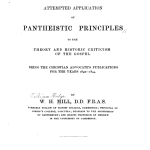
***
I think that I somehow failed to call your attention to this item, which appeared on the website of the Interpreter Foundation on Friday. (You have my apologies.) So here it is:
“Interpreting Interpreter: The Promise of Passover,” by Kyler Rasmussen
This post is a summary of the article “Our Faithful Lord: Passover to Easter” by Rebecca Reynolds Lambert in Volume 51 of Interpreter: A Journal of Latter-day Saint Faith and Scholarship.
An introduction to the Interpreting Interpreter series is available at https://interpreterfoundation.org/interpreting-interpreter-on-abstracting-thought/.
The Takeaway: Lambert provides a deep exploration of the connections between the Jewish Passover and Easter, demonstrating how a greater understanding of Passover can shed light on our relationship to Christ and the nature of the sacrament.
And I’m more than a little bit late with this one, as well:
Interpreter Radio Show — March 20, 2022
In this episode of the Interpreter Radio Show, Mike Parker, Kris Frederickson, and Bruce Webster devoted the first portion of the program to a roundtable discussing the upcoming Come Follow Me lesson #18 (Exodus 24, 31–34). During their second hour, they discussed the conflict in Ukraine and the role of the prophets as emissaries of peace, as well as a recent Interpreter Journal paper on the Fiery Flying Serpents. You can listen to or download the 20 March 2022 broadcast of the Interpreter Radio Show at the supplied link. The Interpreter Radio Show can be heard live on Sunday evenings from 7 to 9 PM (MDT), on K-TALK, AM 1640, or you can listen live on the Internet at ktalkmedia.com.
***
You might find this interesting, related to yesterday’s installment of CBS Sunday Morning:
“The Latter-day Saints’ Sealing Room”
“In this web extra, David Bednar, an apostle of the Church of Jesus Christ of Latter-day Saints, and his wife, Susan Bednar, explain to CBS News’ Ed O’Keefe the symbolism of the temple’s Sealing Room, where rituals are held to make relationships eternal.”
***
I recently read Am I Just My Brain?, by Sharon Dirckx (Oxford UK: The Good Book Company, 2019). Dr. Dirckx — curiously, her surname is pronounced dirix — is a Senior Tutor at the Oxford Centre for Christian Apologetics, with a doctorate in Brain Imaging from the University of Cambridge. Her book is quite readable and clear, and it offers a lucid and informed Christian perspective on current positions regarding neuroscience, the mind, and the brain. I’m going to extract some notes from it for future use, because they caught my interest, and I’ll share a few of them here:
The brain is “a mass of water and fat, weighing just 1.5kg (3.3 pounds.” (14)
“To the touch, the human brain is not unlike the consistency of mushroom. Yet, mercifully, you do not have mushroom between your ears. Quite the opposite. This incredible organ comprises just 2% of the body’s weight, yet it uses 20% of its energy, despite being nearly 75% water. The human brain contains roughly 86 billion brain cells known as neurons. Each of those neurons can send up to 1000 nerve impulses per second to tens of thousands of other cells, at speeds of up to 430 km/h (268 mph). As you are reading these words, your brain is generating enough electricity to power an LED light, and every minute enough blood flows through your head to fill a wine bottle.” (14)
“Changes to the chemistry and physiology of our brains affect our capacity to think. For example, just a small amount of dehydration can dramatically affect our attention span, our memory, and our ability to think clearly. And many of us know that a morning shot of caffeine is vital to kick-start our thinking processes at the beginning of a new day.” (14-15)
“But we now also know that changes to our thinking impact the brain itself. Scientists used to think the brain was fixed and rigid, but it is now known to be incredibly “plastic”, in the sense that it is constantly changing and forming new connections and pathways throughout a person’s lifetime. Changes to the brain affect our thinking. But our thinking, our lifestyle and our habits also shape the way our brains grow and develop.” (15)
Of course, one currently very fashionable view is that the mind and the brain are different ways of viewing the same unitary “object.” As Dr. Dirckx phrases it,
“[T]he mind is the brain. Mind and brain are identical. Thoughts, memories and emotions are the firing of neurons. No more. No less. This view is sometimes referred to as “reductive physicalism”. The mind is reducible (hence “reductive”) to the physical workings of the brain (hence “physicalism”). In other words, there isn’t really such a thing as the mind, but only the activity of the brain.” (24, emphasis in the original).
And many think that this is a new idea, established by modern science. As Sir Colin Blakemore, Professor of Neuroscience at the University of Oxford, put it in 1976,
The human brain is a machine which alone accounts for all our actions, our most private thoughts, our beliefs. All our actions are the products of the activity of our brains. (cited on page 19)
But Dr. Dirckx easily demonstrates that it is not in fact solely a modern, cutting-edge idea. She does so by, among other things, sharing a quotation from the ancient text On the Sacred Disease, which was written by Hippocrates. That ancient Greek physician, who lived between 460 BC and 377 BC, is most generally famous today for his association (whether strictly historical or not) with the so-called “Hippocratic Oath” that is traditionally taken by newly-minted medical doctors:
“Men ought to know that from the brain, and from the brain only, arise our pleasures, joys, laughter, and jests, as well as our sorrows, pains, griefs, and tears.” (cited on page 19, bold emphasis removed)
***
Finally, just a tad late, here are a couple of additional Easter-related items — beyond those that I’ve already shared here over the past eight or nine days or so — that you might find of value. The first is from a mainstream Christian, not a Latter-day Saint. The second is plainly from, umm, members of the Church:
“Only a Stranger in Jerusalem: Not seeing what’s right in front of us is what we Christians do.”
“Leaders Testify of Risen Christ in Easter Social Posts”










